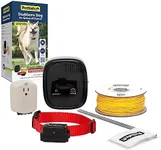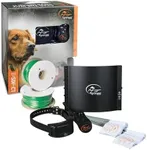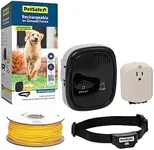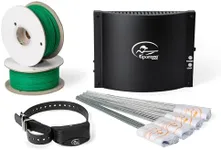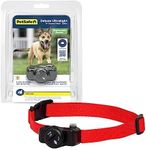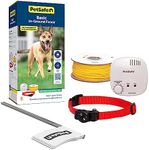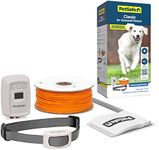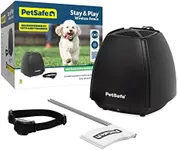Buying Guide for the Best Invisible Fence For Cat
Choosing an invisible fence for your cat is all about ensuring their safety while giving them the freedom to explore your yard or garden. Unlike traditional fences, invisible fences use a combination of a boundary wire or wireless signal and a special collar to keep your cat within a designated area. The right system will depend on your cat’s temperament, the size and shape of your property, and your preferences for installation and maintenance. Understanding the key features will help you make a choice that keeps your cat safe and happy.Type of System (Wired vs. Wireless)The type of invisible fence system refers to how the boundary is created. Wired systems use a physical wire that you bury around the perimeter, while wireless systems use a central transmitter to create a circular boundary. Wired systems are more customizable and can fit irregularly shaped yards, but they require more effort to install. Wireless systems are easier to set up and move, but they work best in open, unobstructed areas and create a round boundary. If your yard has a unique shape or you want precise boundaries, a wired system may be better. If you want quick setup or plan to move the system, wireless could be the way to go.
Coverage AreaCoverage area is the maximum space the invisible fence can enclose. This is important because it determines how much room your cat will have to roam. Coverage can range from small areas suitable for patios or small yards to several acres for larger properties. When choosing, consider the size of the area you want your cat to access. If you have a small garden, a system with a smaller coverage area will suffice. For larger yards, look for systems that can cover more ground or be expanded with additional equipment.
Collar Size and WeightThe collar is what your cat will wear, and its size and weight are crucial for comfort and safety. Cat collars should be lightweight and adjustable to fit smaller necks without causing discomfort. Heavy or bulky collars can be stressful or even unsafe for cats. Always check the minimum weight and neck size recommendations for the collar. If your cat is small or sensitive, prioritize systems with the lightest, most comfortable collars.
Correction Type and LevelsCorrection type refers to how the system alerts your cat when they approach the boundary. Most systems use a combination of warning sounds and mild static correction. The number of correction levels allows you to adjust the intensity to suit your cat’s sensitivity. Some cats respond well to sound alone, while others may need a gentle static correction. Look for systems with multiple levels so you can start with the lowest setting and increase only if necessary. If your cat is timid or easily startled, choose a system with gentle, customizable corrections.
Battery Life and Power SourceBattery life refers to how long the collar will work before needing a recharge or battery replacement. Some collars use replaceable batteries, while others are rechargeable. Longer battery life means less frequent maintenance and less risk of the collar failing. If you prefer convenience, look for rechargeable collars with long battery life. If you don’t mind changing batteries, make sure replacements are easy to find. Consider your routine and how often you want to check or charge the collar.
Water ResistanceWater resistance is important because cats can get caught in the rain or walk through wet grass. A water-resistant or waterproof collar ensures the system keeps working in all weather conditions and prevents damage. If your cat spends a lot of time outdoors or you live in a rainy area, prioritize a collar with good water resistance. For mostly indoor or fair-weather use, this may be less critical.
Ease of InstallationEase of installation refers to how simple it is to set up the invisible fence. Wired systems usually require digging and laying wire, which can be time-consuming. Wireless systems are generally plug-and-play, needing only a power source and some basic setup. If you’re handy and want a custom boundary, a wired system may be worth the effort. If you want something quick and easy, a wireless system is a better fit.
